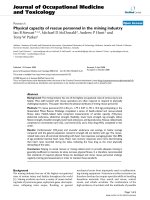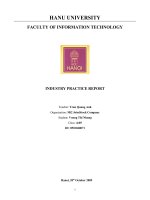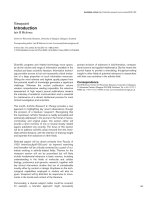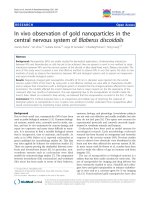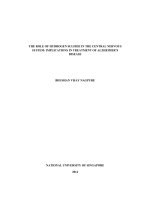Developing leadership capacity of application of information technology in teaching in ethnic minorities boarding lower secondary schools in the Central Highlands region in the current
Bạn đang xem bản rút gọn của tài liệu. Xem và tải ngay bản đầy đủ của tài liệu tại đây (1.54 MB, 7 trang )
KHOA HỌC, GIÁO DỤC VÀ CÔNG NGHỆ
DEVELOPING LEADERSHIP CAPACITY OF APPLICATION
OF INFORMATION TECHNOLOGY IN TEACHING IN ETHNIC
MINORITIES BOARDING LOWER SECONDARY SCHOOLS IN THE
CENTRAL HIGHLANDS REGION IN THE CURRENT PERIOD
Situation and problems raised
Pham Van Truonga
Ngo Quang Sonb
Education and Training Division of
Krongpak District, Lam Dong Province
Email:
b
Vietnam Academy for Ethnic Minorities
Email:
a
Received: 12/9/2019
Reviewed: 17/9/2019
Revised: 24/9/2019
Accepted: 25/9/2019
Released: 30/9/2019
DOI:
/>
B
eing aware of the importance of applying information
technology in teaching to contribute to renovating
teaching methods, district ethnic minorities boarding
lower secondary schools in the Central Highlands Region
have implemented many measures to promote information
technology application in teaching, management and initially
achieving certain results. However, the application of
information technology in teaching at district ethnic minorities
boarding high schools is still very difficult and therefore its
effectiveness is not clear. There are many reasons for this
situation, including the underlying causes of leadership
capacity in applying information technology in teaching. To
gradually overcome this situation, the authors of the article has
conducted a survey to investigate the situation of developing
leadership capacity in the application of information
technology in teaching in district ethnic minority boarding
high schools in the Central Highlands Region in the period
from 2013 to 2018. The authors analyzed the survey results on
the status of leadership capacity development in information
technology application in teaching in district ethnic minority
boarding lower secondary schools, the strengths sides, the
weak sides and the causes of the strengths, weaknesses and
issues to be posed to solve in the current period.
Keywords: Leadership capacity; Develop leadership
capacity; Application of information technology (IT) in
teaching; District boarding lower secondary schools for ethnic
minorities; Central Highlands Region.
1. Introduction
Today information technology deeply affects
all activities of social life in all countries. In order
to absorb such a huge and increasing amount of
knowledge in a short time of studying at schools,
the urgent problem for schools today is to equip
basic knowledge and basic skills and develop
learners’ abilities and at the same time teach
learners how to learn, create their skills, habits and
lifelong passion for learning. Therefore, innovating
teaching content and innovating teaching methods
towards modernization and technologyization are
inevitable.
36
Currently, in the world as well as in Vietnam,
teaching method innovation is taking place
very vigorously in three main trends: positive,
personalized and technology to contribute to
improving teaching and learning quality... In all
three trends, good application of information
technology is needed in the context of Technology
Revolution 4.0.
IT applications have been considered by the
Government, the Education and Training industry
as an important breakthrough in renovating
teaching methods and improving the quality of
education. In the Decision 698/QD-TTg dated
June 21, 2009 of the Prime Minister approving the
JOURNAL OF ETHNIC MINORITIES RESEARCH
KHOA HỌC, GIÁO DỤC VÀ CÔNG NGHỆ
overall plan of developing IT human resources to
2015 and orientations to 2020: IT aims to innovate
teaching and learning methods in the direction that
teachers integrate IT into each subject instead of
learning IT. Subject teachers actively prepare and
select materials and software (open source) to teach
IT applications ”.
Recognizing the importance of applying IT
in teaching to contribute to the innovation of
teaching method, the district boarding lower
secondary schools for ethnic minorities in the
Central Highlands region have implemented
many measures to promote the application of IT
in teaching and managing and initially achieve
certain results. By the 2017-2018 school year, all
district boarding lower secondary schools in 5
Central Highlands provinces are equipped with
computer rooms, multifunction projectors for
ethnic minority students to study and teachers of
the school. 100% of schools have websites that
use effectively in management. However, the
application of information technology in teaching
at secondary education schools is still very difficult
and therefore its effectiveness is not clear. There
are many reasons for this situation, including the
underlying cause of the leadership capacity in the
application of information technology in teaching,
which is still limited: some leaders have not oriented
teachers, being fully aware of the role and meaning
of applying IT in teaching and contributing to
innovating teaching method; Teachers have not
mastered basic computer knowledge and skills.
There are teachers who do not fully understand the
nature of positive teaching lesson plans with IT
applications and active electronic teaching plans that
lead to IT abuse in teaching. Another reason is that
the funding for the procurement of modern teaching
equipment and the construction of infrastructure
for IT application in teaching is limited. For the
above reasons, the authors of the paper chose to
research the topic: “Developing leadership capacity
in the application of Information Technology in
teaching at ethnic minorities boarding high schools
in the Central Highlands in the current period”.
On the basis of theoretical and practical research
on leading the application of IT in teaching, the
research team proposed a system of solutions to
develop the leadership capacity of applying IT
in teaching, contributing to innovating teaching
method and improving high quality of teaching at
district ethnic minority boarding lower secondary
schools in 5 provinces in the Central Highlands
region for Industry Revolution 4.0 trend.
2. Research method
2.1. Group of theoretical research methods
- Studying the Education Law, documents
of the Party and State on education and training
development orientations; Orientation of developing
the application of IT in teaching.
Volume 8, Issue 3
- Studying documents of Ministry of Education
and Training, Departments of Education and
Training related to teaching equipment, innovating
teaching methods, applying IT in teaching.
- Research scientific documents related to the
research topic.
2.2. Group of practical research methods
- Methods of survey by questionnaire: Through
the opinion questionnaires, understanding the
perceptions and aspirations of managers, teachers
and students to collect information on the current
situation of developing leadership capacity in IT
application in teaching at ethnic minorities boarding
lower secondary schools in the Central Highlands
in the current period.
- Method of experts: Giving opinions of experts
in the field of leadership development in the
application of IT in teaching at ethnic minorities
boarding lower secondary schools in the Central
Highlands in the current period.
- Supplementary method: Going directly
to some teaching hours with IT application;
conduct interviews with students, teachers
and administrators; Draw out comments on
the development of leadership capacity in the
application of IT in teaching at ethnic minorities
boarding lower secondary schools in the Central
Highlands in the current period
2.3. Other supporting methods
Using mathematical statistical methods to
process survey data.
3. Overview of the issues research
3.1. Foreign countries
Currently knowledge economy has a great
influence on the economy of each country as well
as the whole world. In the knowledge economy,
knowledge plays a leading role in socio-economic
development. Improving the efficiency of education
and training quality is a measure to develop the
knowledge economy. One of the solutions to
improve the quality of education is to apply IT to
apply new technologies to education. To accomplish
this, the problem for educational managers is:
How to promote the application of IT in teaching
activities? Therefore, the issue of researching
management measures to promote the application
of IT in education has really developed throughout
the world in general and in Vietnam in particular.
In the world, countries with developed
education focused on the application of IT such
as America, Australia, Canada, Japan, Korea,
Singapore, Philippines, Taiwan ... through many
national programs on computerization as well as IT
applications in the fields of science and technology,
in all areas of social life, especially in science and
technology and education. These countries see this
as a key issue of the scientific and technological
revolution, a key to building and developing
37
KHOA HỌC, GIÁO DỤC VÀ CÔNG NGHỆ
industrialization and modernization of the country
and increasing the economy to build and develop.
developing knowledge economy, integration with
countries in the region and around the world. Some
IT policies and programs of IT applications can be
reviewed in the following countries:
The United States: Information technology
- especially the Internet - began to be used in the
United States in 1995 (Wiles and Bondi, 2002) and
then began to be widely available worldwide.
Australia: In March 2000, the Council of
Ministers supported the direction presented in the
“Strategic Structure for the Information Economy”
document, which covers two broad school education
goals for the information economy.
Canada: Currently Canada is a country of
high technology, media, entertainment and arts
development. Canada uses high technology in
almost all areas of operation and pioneers in the
fields of information technology, computers,
telecommunications, transportation, mechanics,
aerospace, urban transportation, microelectronics,
medical instruments, advanced software…
Japan: Develop a national program named “Plan
of an information society - national target until
2000” has been published since 1972.
South Korea: E-government activities and IT
applications are distinguished: Projects involving
many ministries, sectors and localities are considered
as e-government projects funded by central budget.
IT application projects are conducted by each
ministry, sector or locality using recurrent budget
or IT promotion fund under the management of the
Ministry of Information and Communications.
Singapore: In 1981 passed a National
Computerization Act that defined three tasks: First,
to computerize all administrative and governmental
jobs. Second, coordinate education and training
informatics. Third, develop and promote the IT
services industry in Singapore. A National Computer
Committee was established to direct that work.
Philippines: The National IT Plan of the
Philippines, published in 1989, defines a common
strategy to bring IT to the country’s socio-economic
development in the 1990s.
Taiwan: In 1980, Taiwan’s informatics policy was
announced and “The 10-year IT Development Plan in
Taiwan” mentioned the organizational structure of IT
in the country and the contents that the Government
needed to do to develop IT, continue to successfully
compete in the world market.
3.2. Vietnam
Right from the anti-American era to save the
country, the Party and the State had advocated
applying technology - information in a number
of fields. Entering the period of renovation, that
policy has been emphasized and concretized in
many resolutions of the Party and Government.
38
Resolution No.26/NQ/TU, March 30, 1991 of the
Political Bureau on science and technology in the
renovation cause stated: "Focusing on developing
a number of spearhead sciences and technologies
such as electronics, Information Technology...".
Resolution of the Seventh Conference of the
Central Executive Committee (Session VII),
dated July 30, 1994: Prioritizing the application
and development of advanced technologies, such
as information technology, serving electronic
requirements. computerize and computerize the
national economy". The Resolution of the Eighth
National Party Congress emphasized:"Application
of information technology in all fields of the national
economy, creating a change clearly on productivity,
quality and efficiency of the economy...Establishing
a national information network linking with some
international information networks"...In order
to institutionalize the State and the Government
issued Resolution No.49/CP of August 4, 1993
on "Development of information technology in
Vietnam in the 90s".
Implementing the policies of the Party and the
State, since the 70s, information technology in our
country has been applied and developed, making
an important contribution to promoting the socioeconomic development of the country.
The awareness of the whole society about the
role and significance of information technology
has been raised one step. Human resources for
information technology increased significantly.
Telecommunications are developing rapidly in
the direction of modernization. The Government's
Resolution No.07/2000/NQ-CP of June 5, 2000 on
building and developing the software industry in the
2000-2005 period is and will continue to create a
favorable environment for organizations, domestic
and foreign individuals invest, trade, produce and
provide software services. Especially, Politburo's
Directive No. 58-CT/TW of October 17, 2000 on
accelerating the application of IT development for
the industrialization and modernization cause.
Most recently on August 27, 2010, the Prime
Minister signed the Decision No.1605/ QD-TTg
approving the National Program on IT application
in state agencies' activities for the period of 20112015 with total investment over 1700 billion dong.
There are also 20 national projects on IT application
that are approved by the Prime Minister.
In Education and Training: From the 20082009 school year selected as the school year with
the theme: "The academic year of information
technology application and financial management
innovation" shows that the Ministry of Education
and Training has been very important. pay attention
to the application of IT in schools through the
school year mandate...in the following school years,
the Ministry of Education and Training continues
to direct: "Promote the application of information
technology in educational management. education,
JOURNAL OF ETHNIC MINORITIES RESEARCH
KHOA HỌC, GIÁO DỤC VÀ CÔNG NGHỆ
unified state management on IT application in
Education and Training ... ”
In recent years, the application of IT in
management and organizing teaching activities
has been interested in many scientists. Scientific
conferences and seminars on IT research have
mentioned a lot about IT application management in
education and the ability to apply to the Education
and Training environment in Vietnam such as:
- Scientific conference "Research and
implementation of E-Learning" organized by the
Information Technology Institute (Hanoi National
University) and the Faculty of Information
Technology (Hanoi University of Technology)
organized in early March 2005 was the first
scientific conference on IT application in the
education system held in Vietnam.
- National scientific conference on IT:
"Technology and management solutions in IT
application in teaching method innovation"
organized by Hanoi University of Education
in collaboration with Higher Education Project
May 9-10, 2006. The main contents of the
seminar are: Technology solutions in teaching
method innovation (high school, university and
postgraduate), IT development strategy in teaching
method innovation. The results and experiences
of applying IT in teaching: Building and using
teaching software, electronic learning materials,...
The 2010 National Conference on Information and
Communications of Vietnam (held on December 3,
2010) evaluated Directive No.58-CT/TW to mean a
wise, correct and practical policy of the Politburo,
creating a positive turn for the development of IT
industry. The conference also evaluated the results
achieved over 10 years of implementing Directive
58 in 5 aspects: State management, IT application,
IT industry development, IT human resource
development and lower development.
On December 22, 2015, in Da Nang, Department
of Information Technology (Ministry of Education
and Training) organized a seminar on “Enhancing
the application of information technology to meet
the requirements of fundamental and comprehensive
innovation in education and training”. During the
seminars, scientists and managers raised issues
of research on the importance, application and
development of IT, especially solutions to promote
IT application in education.
In recent times, there have been a number
of scientific master’s theses on IT application
management in teaching in high schools in our
country successfully protected such as:
- Author Bui Thi Ngoc Quyen researches the
subject: “Measures to manage IT application in
teaching at secondary schools in Le Chan District,
Hai Phong City”. Done in 2010 at Hanoi National
University of Education.
- Author Pham Anh Tuan researched the topic:
Volume 8, Issue 3
“Solutions for managing IT applications in teaching
at high schools in Ha Nam province” studied
theoretical issues about the management of IT
applications in education. Find out the reality of the
management of IT application in teaching, propose
some measures to manage IT application in teaching
of high schools in Ha Nam province, Implement at
the Institute of Education Management year 2012.
- Author Vu Van Hung researches the subject:
“Measures to manage IT application and
communication in teaching at high schools in Giao
Thuy district, Nam Dinh province” has systematized
the basic issues of management and application. IT
application in education, Implemented at the 2013
Academy of Educational Management. Through
research, the authors affirmed the significance of
the application of IT in teaching, contributing to
innovating teaching methods and the important role
of management measures. From the above works,
the author found that developing leadership capacity
in the application of Information Technology
in teaching at ethnic minorities boarding lower
secondary schools in the Central Highlands region
in the current trend of Industry Revolution 4.0, it is
very important and urgent.
4. The reality of developing leadership
capacity in the application of Information
Technology in teaching at ethnic boarding high
schools in the Central Highlands region in the
current trend of Industry Revolution 4.0
4.1. Lead the construction and use of
multimedia classrooms
By the end of the school year 2018-2019, the
district ethnic minorities boarding lower secondary
schools have built up multimedia classrooms.
When we conducted a survey on the educational
management staff of 25 district boarding schools
for the ethnic minorities, the following results were
obtained: Of the 25 leading officials of 25 district
junior boarding boarding schools The Central
Highlands region, which was surveyed, found that
the construction of multimedia classrooms was
really necessary.
4.2. Lead the use of teaching software and
effective Internet access
Currently, there are no specific regulations
on teachers’ leadership to exploit information on
the internet. This is an issue that leaders in ethnic
minority boarding lower secondary schools in
the Central Highlands need to be concerned and
propose appropriate remedies.
4.3. Leading the design and use of positive
teaching lesson plans with IT applications
4.3.1. Planning work
The Departments of Education and Training
have issued documents guiding the application of
IT in schools for each school year. The schools
have based on the guiding documents to plan for
39
KHOA HỌC, GIÁO DỤC VÀ CÔNG NGHỆ
the implementation of IT applications, as well as
the preparation of active teaching plans with IT
applications, and plans to organize lectures and
associations. Active Teaching – Learning Lesson
Plan contest with IT applications, proposing
solutions to implement that plan, also planning
to buy modern teaching equipment and putting
the design and use of Active Teaching – Learning
Lesson Plan with IT applications. However, the
plan does not really stick to the actual situation
of pedagogical competence, computer literacy of
teachers and school facilities in general and modern
equipment of the school in particular.
4.3.2. Organization of implementation
The organization of implementation of the
schools has not been agreed. At the same time, the
process of designing Active Teaching – Learning
Lesson Plan with the application of IT does not yet
have specific instructions, the leaders of the junior
secondary education schools are still confused in
the implementation stage from the planning to train
teachers for IT, Procurement of modern equipment
and materials to the stage of coordinating resources.
4.3.3. Steering work
Having ensured the unified direction from the
professional steering agencies, the Departments
of Education and Training advised the District
People’s Committee to provide funding for the
construction of the web portal, linked to the
website of all schools in the area. Direct teachers in
schools to actively put up lesson plans, especially
lectures and competitions. However, there are still
problems and shortcomings such as orientation
for teachers about the design and effective use of
Active Teaching – Learning Lesson Plan with IT
applications. How to teach in class? Teach what?
What was the composition like? Ideas and design
like? Many Active Teaching – Learning Lesson
Plan design refresher courses with IT applications
for teachers have not been organized.
4.3.4. Inspection and evaluation
Assessment is a very important activity in the
work of leading officials. The leaders of the schools
have set out right from the stage of planning and
organizing the implementation through lectures,
scheduled hours or contests...However, the
adjustment, repairing and rectifying the design
and using Active Teaching – Learning Lesson Plan
with IT application has not been implemented
effectively. Because in fact, there are many times
when launching and planning the organization of
implementation are not concerned, but the stage
of summarizing and drawing experience from the
implementation process has not been paid attention.
* General comment
Designing lesson plans of teachers is one of the
important tasks of the school’s leadership team. The
results obtained when conducting the survey on this
issue in 25 schools are as follows: 100% of the
40
managers of the ten schools think that in order to
improve the quality of teaching hours, it is necessary
to strictly manage the design and use lesson plans
of teachers. However, the leaders of 25 schools also
said that managing the lesson plans of the entire
school teachers, especially when preparing lectures
with Active Teaching – Learning Lesson Plan using
IT is very difficult.
4.4. Leadership in applying IT in the examination
and evaluation of learning results of ethnic minority
students
First of all, evaluation is a stage and an
important tool which is indispensable in the
educational process; functions, adjusts the teaching
and learning process, is a motivation for innovating
teaching methods, contributing to improve and
improve teaching quality. Assessment has many
implications for learners, teachers as well as
managers. Through the assessment and evaluation,
it also helps ethnic minorities students adjust
their learning methods, knowledge and skills and
motivate them to strive better.
Using IT in renewing the examination and
assessment of learning results of ethnic minority
students in schools helps to quickly check the grasp
of basic knowledge of students, the results are more
objective and take advantage of opportunities for
students to practice self-assessment and assessment
skills. IT applications make managing student
results more convenient.
4.5. Assessment of the current situation of
information technology application and the
situation of leadership in the application of
information technology in active teaching in
district-level ethnic minorities boarding lower
secondary schools in the Central Highlands region
4.5.1. Strengths
The leadership team and most of the university’s
teachers are aware of the importance of applying
IT to active teaching and innovating teaching
methods. School facilities in general and teaching
equipment in particular necessary for the IT
application were initially invested. The connection
to the Internet with ADSL transmission line - an
important condition for promoting and improving
the quality of IT application in teaching has been
implemented by 25 junior secondary education
schools. From the school year 2012-2013 until
now, the Departments of Education and Training
has issued a lot of guidelines on IT application for
secondary education schools.
Computing skills and skills of leaders, teachers,
and staff of junior secondary education schools are
guaranteed from basic upwards. Cadres in charge
of information technology at district–level ethnic
minorities boarding lower secondary education
schools have intermediate education level or
higher of 100%.
The application of IT in school management
JOURNAL OF ETHNIC MINORITIES RESEARCH
KHOA HỌC, GIÁO DỤC VÀ CÔNG NGHỆ
expressed through the electronic information
exchange online between the Departments of
Education and Training and the schools in the area
via the website has good effect. The application of
IT in teaching and learning also achieved a number
of results, such as: the Department of Education
and Training has proposed measures to encourage
the application of IT in teaching, building an
electronic document system for teaching. 55%
of surveyed schools already have an electronic
learning library. Number of thematic innovations
in teaching methodology with IT applications at
all levels in a year. The percentage of lectures with
IT applications at lower secondary level in lectures
and contests at district level reaches 100%, the rate
of teachers using Internet for teaching is 88%, the
rate of students using Internets at the school is 35 %.
Activities of exchanging and learning IT experience
are also focused (Hoa & Son, 2008).
4.5.2.Weak side
- The construction of a common database for IT
application in teaching and learning is not effective,
the database is poor.
- The facilities of the schools in general and the
teaching equipment in particular for the application
of IT in teaching are lacking compared to the
actual needs in the schools: The number of high
school classrooms; Electronic library room ... The
exploitation of existing equipment has not reached
a high frequency. The skills to use modern teaching
equipment of teachers are not proficient and fluent.
Teachers have not been proactive in preserving
modern teaching equipment.
- The design of Active Teaching – Learning
Lesson Plan with IT application is still spontaneous
without the active management of the school.
- And teachers misuse IT leading to ethnic
minority students not timely recording the content
of the lecture, the teaching process becomes passive
making the lesson less effective. So with this way,
teachers make the teaching process more passive
than “read-write”. School leaders and teachers are
not active in designing and using Active Teaching
– Learning Lesson Plan with IT applications (Hoa
& Son, 2008).
4.5.3. Analyze objective and subjective reasons
The limitations and inadequacies of the
application of IT and the leadership of IT
applications in renovating teaching methodology at
junior secondary education secondary schools have
both objective and subjective causes.
4.5.3.1. Objective reasons
Funds for investment in modern equipment
and equipment procurement, construction of
infrastructure for IT application in teaching are
limited. The number of lesson plans of teachers per
week is high, so teachers do not have much time
to prepare teaching plans for teaching. Meanwhile,
Volume 8, Issue 3
in addition to compiling lesson plans, teachers also
have to make many types of books included in the
teacher’s file, all kinds of thematic lesson plans,
extra-curricular lesson plans, topic-based teaching,
practical lessons. show the work of universalizing,
participating in competitions, guiding students to
participate in contests...The district – level ethnic
minorities boarding lower secondary schools in
the province are under pressure of the increase in
mechanical population.
4.5.3.2. Subjective reasons
The application of information technology
in teaching at district – level ethnic minorities
boarding lower secondary schools for secondary
education still has many shortcomings. The attention
of managers and leaders is not strategic; thereby
leading to unsynchronized infrastructure investment.
Since then, the improvement of computer literacy for
teachers is uneven and basic. These are the reasons
that make the application of information technology
in teaching in general and in district – level ethnic
minorities boarding lower secondary schools in
particular very difficult and its effectiveness is not
so clear. Human resources for IT application in
management and support for teachers in teaching are
still lacking (Hoa & Son, 2016).
5. Conclusion
Through studying the current situation of IT
application in district – level ethnic minorities
boarding lower secondary education schools,
the authors found that: to effectively apply IT in
teaching, avoid IT abuse, requires consistency
from awareness to specific jobs, the participation in
educational management, school leaders, teachers
and ethnic minority students. In which, playing
an important role is the contingent of leaders,
managers, teachers and staff of the district – level
ethnic minorities boarding junior secondary schools.
Practice shows that to improve the quality
of teaching, it is necessary to coordinate many
solutions, with unified leadership from educational
management levels in which the application of
IT in teaching contributes to innovating teaching
method is a right direction of lower secondary
schools. From the results of the survey and the use
of software to analyze in detail the current situation
of IT application in innovation of teaching method
and the situation of leadership in IT application
in teaching and management at 25 district –
level ethnic minorities boarding lower secondary
schools in the Central Highlands region will be a
convincing practical basis for the authors to come
up with a system of leadership solutions to apply
IT in teaching, contributing to innovating teaching
method for ethnic minority students, improving
the quality of education of district – level ethnic
minorities boarding lower secondary schools in
the current trend of technology revolution 4.0
(Bao, 2007).
41
KHOA HỌC, GIÁO DỤC VÀ CÔNG NGHỆ
References
Bao, D. Q. (2007). A handbook for improving
school management capacity. Hanoi:
National Political Publishing House.
Bao, D. Q., & Hung, N. D. (2004). Vietnam
Education towards the future of problems
and solutions. Hanoi: National Political
Publishing House.
Chau, N. P. (2010). School Manager. Hanoi:
Hanoi University of Education Publishing
House.
Giáp, T. X. (1997). Teaching facilities. Hanoi:
Education Publishing House.
Hoa, P. D., & Son, N. Q. (2008). Application of
information technology in active teaching.
Hanoi: Education Publishing House.
Hoa, P. D., & Son, N. Q. (2011). Methods
and teaching technologies in pedagogical
interactive environment. Hanoi: Publisher of
Pedagogical University.
Hoa, P. D., & Son, N. Q. (2016). Methods
and teaching technologies in interactive
pedagogical environment (First and
supplemented edition). Hanoi: University of
Pedagogy Publishing House.
Kiem, T., & Hien, B. M. (2004). Curriculum on
management and school leadership. Hanoi.
Korean E-Government. (2008). PCWorldVN
Magazine.
National Assembly of the Republic of Vietnam
National Import and Export. (2006). Law on
Information Technology. Hanoi.
Son, N. Q. (n.d.). Design and effective use of
electronic lesson plans in a multimedia
learning environment.
Toomey,
R.
(n.d.).
Information
and
Communication Technology for Teaching
and Learning, Lifelong Learning Center.
PHÁT TRIỂN NĂNG LỰC LÃNH ĐẠO ỨNG DỤNG CÔNG NGHỆ
THÔNG TIN TRONG DẠY HỌC Ở CÁC TRƯỜNG PHỔ THÔNG DÂN TỘC
NỘI TRÚ KHU VỰC TÂY NGUYÊN TRONG GIAI ĐOẠN HIỆN NAY
Thực trạng và những vấn đề đặt ra
Phạm Văn Trườnga
Ngô Quang Sơnb
Phòng Giáo dục và Đào tạo huyện
Krongpak, tỉnh Lâm Đồng
Email:
b
Học viện Dân tộc
Email:
a
Received: 12/9/2019
Reviewed: 17/9/2019
Revised: 24/9/2019
Accepted: 25/9/2019
Released: 30/9/2019
DOI:
/>
42
Tóm tắt
Nhận thức rõ tầm quan trọng của việc ứng dụng công nghệ thông
tin trong dạy học nhằm góp phần đổi mới phương pháp dạy học, các
trường phổ thông dân tộc nội trú cấp huyện khu vực Tây Nguyên
đã triển khai nhiều biện pháp nhằm đẩy mạnh ứng dụng công nghệ
thông tin trong dạy học, quản lý và bước đầu đạt được một số kết
quả nhất định. Tuy nhiên, công tác ứng dụng công nghệ thông tin
trong dạy học ở các trường phổ thông dân tộc nội trú trung học cơ
sở còn rất khó khăn và hiệu quả của nó vì thế cũng chưa rõ nét. Có
nhiều nguyên nhân dẫn đến thực trạng này trong đó có nguyên nhân
cơ bản thuộc về năng lực lãnh đạo ứng dụng công nghệ thông tin và
truyền thông trong dạy học còn nhiều hạn chế. Để khắc phục từng
bước thực trạng này, nhóm tác giả bài báo đã tiến hành điều tra khảo
sát thực trạng phát triển năng lực lãnh đạo ứng dụng công nghệ
thông tin trong dạy học ở các trường phổ thông dân tộc nội trú cấp
huyện (trung học cơ sở) khu vực Tây Nguyên trong giai đoạn từ năm
2013-2018. Nhóm tác giả đã phân tích kết quả khảo sát về thực trạng
phát triển năng lực lãnh đạo ứng dụng công nghệ thông tin trong dạy
học ở các trường phổ thông dân tộc nội trú, những mặt mạnh, những
mặt yếu, nguyên nhân của những mặt mạnh, mặt yếu và những vấn
đề cần đặt ra để giải quyết trong giai đoạn hiện nay.
Từ khóa
Năng lực lãnh đạo; Phát triển năng lực lãnh đạo; Ứng dụng công
nghệ thông tin trong dạy học; Trường phổ thông dân tộc nội trú; Khu
vực Tây Nguyên.
JOURNAL OF ETHNIC MINORITIES RESEARCH

